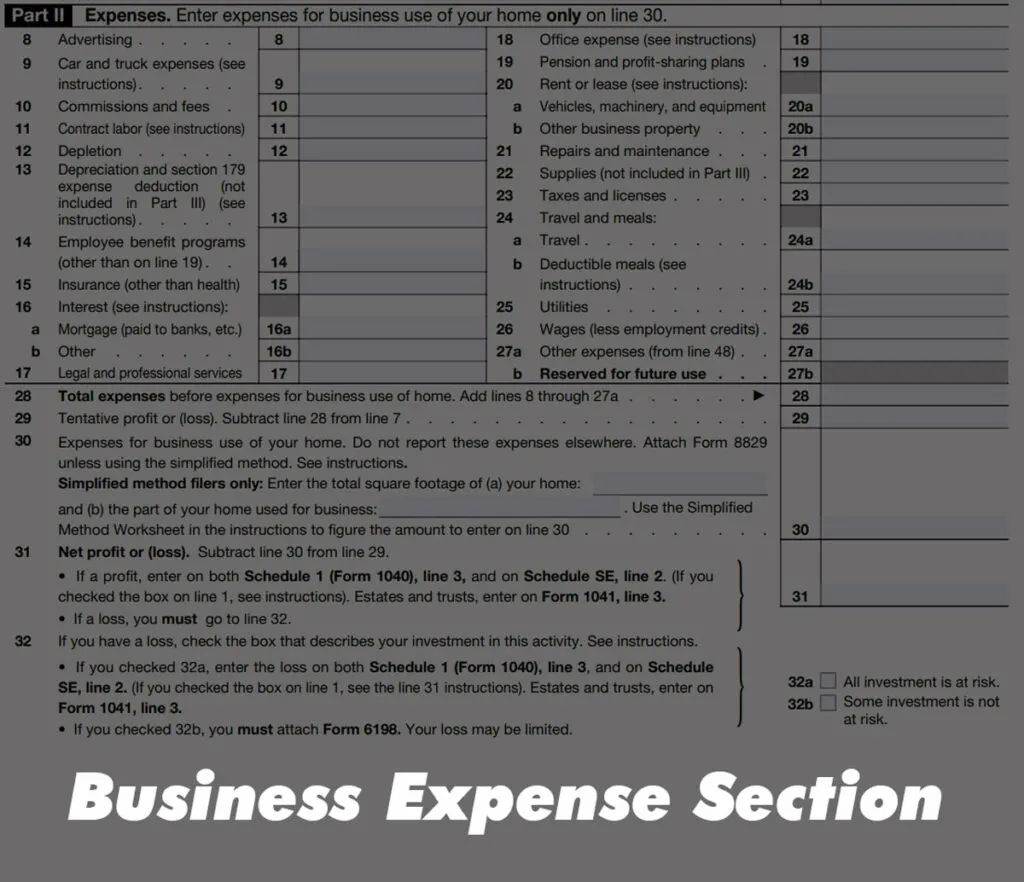You’ll hear a lot about IRS form Schedule C if you’ve done much research on delivery driver taxes.
What exactly is form Schedule C, and why is it so important? Can we file taxes without it?
Schedule C is the linchpin of your independent contractor taxes. It’s the form that lets you claim business expenses regardless of whether you itemize your tax deductions. Schedule C can make a huge difference in your taxes.

We’ll take a look at this critical document, how it works, and how to fill it out:
- What is Schedule C?
- Entering your business and personal information
- The five parts of Schedule C
- What happens after Schedule C is completed?

About this article
The purpose of this article is to explain how form Schedule C works, especially for gig economy delivery contractors. It’s also one of several articles in a series about delivery driver taxes. We’ll link to other articles where appropriate, and you can view the entire list of posts here.
Understand that this is about independent contractor taxes in the United States. Other nations have their own tax regulations and may do things differently. You should seek a tax professional to help you with your local and national tax situation.
This is not tax advice. The purpose is to educate and explain how U.S. taxes work for independent contractors. If you need advice about your particular tax situation, you should seek a tax expert who can guide you individually.
What is Schedule C and why is it important to independent contractors?
The best way I can put it is that Schedule C is the closest thing gig workers have to a W-2 form. It is the actual earnings statement for your independent contractor business.
1099 forms you receive from Doordash, Instacart, Lyft, Grubhub, Uber Eats, or other gig companies don’t do that for you. All that those forms do is report your business’s income.
You are a sole proprietor if you’re an independent contractor (unless you’ve created a partnership, an LLC or incorporated in some other way). Because you provide services as a business rather than as an employee, your taxable income is your profit. In other words, it’s what’s left over after expenses.
It’s up to you to provide the correct information to the IRS to determine taxable income. Schedule C is the form that does that. On that form, you list your income, then add up your expenses. Subtract expenses to get profit. Profit then gets moved over to your tax form as personal income.
Entering your personal and business information.

The first part of the form is a section where you enter identifying information about yourself and your business.
This is the part where we’ll spend most of our time for this article. That’s for two reasons:
- It’s the part of Schedule C that often creates the most confusion
- We go into much more detail in other articles about the income and the expenses you can claim for your business. We’ll provide links to point to those articles where appropriate.
Small businesses that report income on Schedule C are known as pass-through entities. That means that the business itself is not taxed by the federal government. Instead, profits pass through to the personal tax returns of the business owner (or owners).
The first part of Schedule C aims to identify both the business and the individual (or individuals) who pay tax on the business income. As we look at these items, we’ll look at them as a typical independent contractor in the gig economy would fill them out.

Name and Social Security Number.
This part identifies the individual who will pay taxes on the profits from the business. Enter your legal name and social security number as it appears on your 1040 tax form.
Line A: Describe your business.
The IRS asks for the “principle business or profession, including product or service.” Here you provide a brief description of what your business does.
I use something like “third-party on-demand delivery service” I don’t think the IRS is too worried about whether you phrased it exactly right. The main idea is to provide a general description.
Line B: Business Code

The IRS has more than two pages of business codes to choose from (pages C-18 through C-20 of the 2021 instruction book). Many businesses fit into more than one, so you want to select the code that best describes your business.
The best code for those of us who do mostly delivery work is under Transportation and Warehousing with code 492000 Couriers & Messengers.

Rideshare drivers might choose 485300 Taxi, Limousine, and Ridesharing Service.
This number can be pretty important. There are several different business types, and each has its own patterns as to the kind of expense.
It can be especially useful in avoiding red flags for audits. The mileage allowance is one of the most frequently abused business deductions. For most small business owners, 30,000 business miles is enough to get someone’s attention. However, higher mileage is more typical for rideshare and delivery.
At the same time, you’re also telling the IRS that you probably don’t have office space or have qualifying home office use. Therefore, your business code could avoid some red flags but raise others.
Line C: Business Name

Only fill this out if you have formally created a business name, such as if you have incorporated or created an LLC. Most delivery contractors are sole proprietors and would leave this blank.
Line D: Employer ID Number (EIN)
If you have received an Employer ID Number from the IRS, enter it here. Getting an EIN as a sole proprietor is possible without incorporating or creating an LLC. For example, many independent contractors get an EIN to open a business banking account.
Line E: Business address
Most gig contractors will enter their home address as it appears on their 1040 form. The exception is if you have an established office distinct from your home.
Line F: Accounting method
You will most likely check “Cash” as your accounting method. If you use Accrual or another form of accounting, you would probably know it. Check with your tax professional for further verification.
Line G: Do you materially participate in the operation of your business?
This question asks if you are actively involved in the operation of your business. The answer is almost certainly yes.
Line H: Did you start your business this year?
If this is the first year you filed a Schedule C for this type of independent contracting, you should check this box.
Lines I and J: Will you need to file a 1099 form?
Many contractors get confused by this question. Understand that it does NOT ask if you RECEIVED a 1099 form. It’s asking if you need to send a 1099 to someone else.
You would only check this off if you paid someone else $600 or more to perform work for your business. For example: if you hired a subcontractor to do some delivery work for you.
The five parts of Schedule C
Five sections of Schedule C get filled out after you’ve filled out personal and business information. We’ve written entire articles to cover many of these, so we’ll link to those articles rather than go into extra detail.
Part I: Income

This is where you enter the income that your business received. On line 1, you total up earnings and customer tips from the different gig companies and enter the total here.
Here is where you also deduct the cost of goods sold, though that’s an unusual item for most delivery contractors. This article goes into more detail about delivery contractor income.
Part II: Expenses

The IRS requires you to break down your expense totals by category. They have twenty such classifications. We go into detail here about each category and typical delivery driver deductions for each.
Line 28 adds up the total business expenses. Line 29 subtracts expenses from income to establish a tentative profit or loss.
If you qualify for a home office deduction (most gig economy workers do not), enter that on line 30. Subtract it from your tentative profit to determine net profit. Note that you can not take the home office deduction if you had a business loss for the year.
Part III: Cost of Goods Sold
This section is used as a worksheet to determine the Cost of Goods Sold figure entered on Line 4 of the income section. Cost of Goods Sold refers to the cost of materials and production of items sold by your business. Gig economy independent contractor work rarely involves product sales, so we won’t discuss this item in further detail.
Part IV: Information on your Vehicle

This section is where you enter additional details about your vehicle deduction (line 9 in the income section). It asks when you first used your car for business and how many miles were driven for business, commuting, and other purposes.
Question 47 of this section is critical. It asks if you have evidence to support your deduction (a) and if the evidence is written (b). The implication is that you can not claim vehicle costs (either mileage or actual expenses) without evidence of business use. You can read more about how to track your miles to get such proof.
Part V: Other Expenses

Suppose you had expenses that did not fit the business categories in lines 8-26 in business expenses. In that case, you must enter the total of other expenses on line 27. In Part V, you break down those “other expenses with a description and total for each.
You can read more about typical contractor deductions in the “other” category.
What happens after Schedule C?
Once you have determined your net profit (line 31), two things happen with it.
First, that net profit is added to any other income in the Income Section of your 1040 tax form. We write more about how your business profit determines your income tax bill.
Second, the same amount is entered into IRS form SE, which determines your Self-Employment tax. This article explains more about how Self-Employment tax works for delivery contractors.
The Delivery Driver’s Tax Series
The Delivery Driver's Tax Information Series (Grubhub, Doordash, Postmates, Uber Eats, Instacart)
The Delivery Driver's Tax Information Series is a series of articles designed to help you understand how taxes work for you as an independent contractor with gig economy delivery apps like Doordash, Uber Eats, Grubhub, Instacart, and Postmates. Below are some of the articles
What are your delivery driver taxes based on?
It is important to understand your taxable income is your profit, NOT your pay from Grubhub Doordash Postmates Uber Eats etc. Schedule C figures that.
How does itemizing or taking the standard deduction affect writing off delivery driver business expenses?
We examine the difference between business expenses and tax deductions, and why you can claim your expenses even when taking the standard deduction.
Tax Guide: Understanding Your Income
The following three articles help you understand what your real income is as an independent contractor.
Understanding business income as a 1099 gig worker
What income do you have to report as a contractor for Grubhub, Doordash, Postmates, Uber Eats and other delivery gigs? How and where do you report?
What are 1099 forms and what do we do with them?
Episode 57 of the Deliver on Your Business Podcast. Once you receive your 1099 forms from Doordash, Uber Eats, Grubhub, Postmates and others, what do you do with them?
What If My 1099 is Wrong?
What if the amount reported on your 1099 is incorrect? This is not an uncommon problem. Do NOT just let it ride, incorrect information could cost you a lot in extra taxes
Tax Guide: Understanding Your Expenses
The following eight articles help you understand the expenses you can claim on your Schedule C. Most of these are about your car, your biggest expense.
How do business expenses work for Delivery Drivers in the gig economy?
Introducing and explaining the business expenses as they are claimed on your taxes as a contractor for Grubhub, Doordash, Postmates, Uber Eats.
How to write off car expenses for gig workers
For those of us who do use our cars for gig economy delivery, the car expense is the largest expense item. You can choose between the standard mileage allowance and actual expenses.
How to Track Your Miles As a Delivery Contractor
Every mile that you track as a contractor delivering for Doordash, Uber Eats, Grubhub, Instacart, Lyft etc, is saves about 14 cents on your taxes. When you drive thousands of miles, that adds up.
What Miles can you and can you not claim for delivery and rideshare?
What miles can I claim when delivering for Grubhub, Doordash, Postmates, Uber Eats and other delivery gigs? Understand what miles you can and cannot claim.
What if I Forgot to track my miles?
What do I do if I didn't track my miles as a gig economy driver? We look at different places you can find evidence to use in building a mileage log.
How the actual car expense method works for gig workers
It is important to understand your taxable income is your profit, NOT your pay from Grubhub Doordash Postmates Uber Eats etc. Schedule C figures that.
Three Car Expenses Gig Economy Drivers May Not Know You Could Claim Even When Claiming the Mileage Deduction
You probably didn't realize that even if you claim the standard mileage deduction, there are some car related expenses you can still claim.
Besides My Car, What Other Business Expenses can I claim for Grubhub Doordash Postmates Uber Eats etc?
Besides your car, what expenses can you claim as a contractor for Grubhub, Postmates, Uber Eats, Doordash etc? We look at some different possible expenses.
Filling Out Your Tax Forms
Once you understand your income and expenses, what do you do with them? Where does all this information go when you start filling out your taxes?
Understanding Self Employment Taxes for Delivery Drivers for Grubhub, Doordash, Postmates, Uber Eats etc.
Understand how self employment tax works as a contractor for Grubhub, Uber Eats, Doordash, Postmates or any other gigs. Know what it is,how much & be ready!
Understanding the Income Tax Process For Grubhub, Postmates, Doordash, Uber Eats Contractors
How does our self employed income from Grubhub Doordash Postmates Uber Eats etc impact our income tax? We walk through the process on the 1040 form.
Here are Four Tax Deductions for Self Employed Contractors That Don't Go on Schedule C.
Most of our deductions as self employed contractors go on Schedule C. Four deductions benefitting Grubhub Doordash Postmates Uber Eats Contractors.
Do 1099 Delivery Drivers Need to Pay Quarterly Taxes?
We look at how quarterly tax payments work for gig economy workers (Uber Eats, Doordash, Grubhub, Instacart, Uber, Lyft, etc.)
How Much Should I Save for Taxes? | Grubhub Doordash Uber Eats
How much should I save for taxes when delivering for gigs like Grubhub, Doordash, Postmates, Uber Eats and others? These ideas help you prepare for taxes.





















